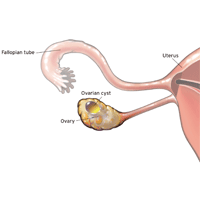Few medical conditions mirror the pain of a burst appendix. But women with a ruptured ovarian cyst say it comes close. “I couldn’t walk or put pressure on my right leg because the pain was so excruciating,” says Sarah Fey, 38, who has type 1 von Willebrand disease (VWD). “I thought maybe I was having appendicitis,” says the project coordinator from Gilbert, Arizona.
Therein lies the problem—confusion about ovarian cysts and their complications. Women with bleeding disorders need to know if they’re susceptible to ovarian cysts and how to manage them.
Ovulation obstacles
Every month, the body prepares for pregnancy by forming a follicle, a fluid-filled sac, around the egg. Normally, the follicle breaks open, releases the egg, then dissolves. However, if the follicle fails to open or dissolve, a cyst forms. As fluid builds up in it, this follicular, or functional, cyst grows. According to the US Centers for Disease Control and Prevention (CDC), ovarian cysts are common during the childbearing years. Most go away on their own without issue.
But the situation is different for women with bleeding disorders, says Andra H. James, MD, ob/gyn at the University of Virginia School of Medicine in Charlottesville. That’s because these women can bleed even during normal ovulation, when the egg is released from the follicular sac. And the bleeding can be significant. “They’re at risk for hemorrhagic ovarian cysts,” James says. “They can bleed into the sac itself and into the abdomen.”
An emergency room visit six years ago led to the discovery that Brooke Connell, 31, was prone to ovarian cysts. “I had a hemorrhagic ovarian cyst that ruptured,” says the PR/marketing specialist from Kansas City, Missouri. “When they did the ultrasound, they could see the blood around it.”
Connell, who has type III VWD, was then diagnosed with polycystic ovary syndrome, the inability to produce mature follicles. To get pregnant, she’s undergone treatments for infertility. “During several cycles we’ve had to stop the medication that stimulates the ovaries to produce more eggs because I’ve had large cysts on one or both ovaries,” says Connell.
Ovarian cysts also occur in women with other bleeding disorders, such as hemophilia, rare factor deficiencies and platelet defects.
Subtle and serious symptoms
Mild ovarian cyst symptoms can be easily dismissed. For instance, stomach pain, bloating and a dull ache in the back can be mistaken for premenstrual syndrome. Fey experienced a cluster of such symptoms in 2013. Pressure in her abdomen was one sign. “I felt full even at times when I was hungry,” she says. Needing to urinate at night was chalked up to aging. But heavier menstrual bleeding sent her to her doctor. “An ultrasound last fall revealed cysts on both sides,” she says.
The larger the cyst, the more pain a woman will feel, says James. When they’re about 5–10 cm (2–4 inches), they can begin to cause problems. Connell’s was 6 cm (2 1/3 inches) when it ruptured. Ruptured cysts can cause internal bleeding, sometimes with severe pain. “Very large cysts can cause the ovary to twist on itself, but that’s in extreme cases,” James says. This torsion of the ovary can cut off blood supply, resulting in permanent infertility.
Treatment factors
Treatment for ovarian cysts depends on several factors. If they’re small and asymptomatic, they may resolve on their own within three months or so. Although Fey currently has cysts on both ovaries, she’s not anxious. “They’re non-fluid-filled, so they are not a concern at this time,” she says.
Sometimes conservative measures are called for when a woman has hemorrhagic ovarian cysts. “We’ll try to correct the underlying bleeding problem and watch the woman very carefully in the hospital until the symptoms improve,” says James. But other times surgery is needed to remove a cyst or damaged ovary, especially if there’s acute pain and severe bleeding.
Preventive measures
 Contraceptives can prevent ovarian cyst formation by inhibiting ovulation. The progesterone-estrogen combination pills that contain the same daily dose (monophasic), Depo-Provera injections and subdermal implants containing the hormone etonogestrel are all effective. “Only these methods are going to protect a woman from hemorrhagic ovarian cysts,” says James. Progestin-only pills and the levonorgestrel-containing IUD, often prescribed for women with bleeding disorders who have menorrhagia (heavy menstrual bleeding), however, do not work, she adds.
Contraceptives can prevent ovarian cyst formation by inhibiting ovulation. The progesterone-estrogen combination pills that contain the same daily dose (monophasic), Depo-Provera injections and subdermal implants containing the hormone etonogestrel are all effective. “Only these methods are going to protect a woman from hemorrhagic ovarian cysts,” says James. Progestin-only pills and the levonorgestrel-containing IUD, often prescribed for women with bleeding disorders who have menorrhagia (heavy menstrual bleeding), however, do not work, she adds.
Expanding education
Chances are, most women are not familiar with ovarian cysts. “My mom has mild VWD, but she never had cysts,” Connell says. Much of her information and support have come from her hemophilia treatment center (HTC). “I am in contact with my nurse at the HTC a lot, so if I ever have trouble, I just call her,” she says. “She’s been a blessing when it comes to communicating with my other doctors about the plan for me or when I should dose.”
Healthcare providers also need education about the risk of hemorrhagic ovarian cysts in women with bleeding disorders. “We’ve educated around this over the last decade, so more of them know about it,” James says. Patients can take the lead, too. “Even as a teenager, women need to begin this discussion.”

